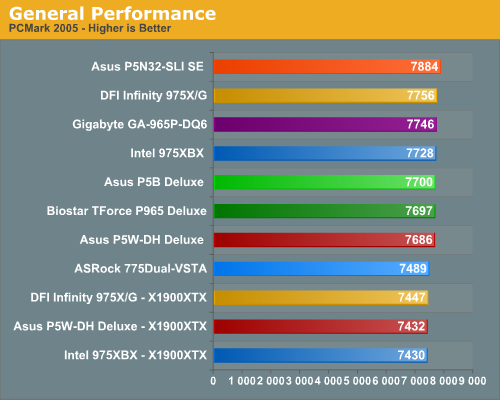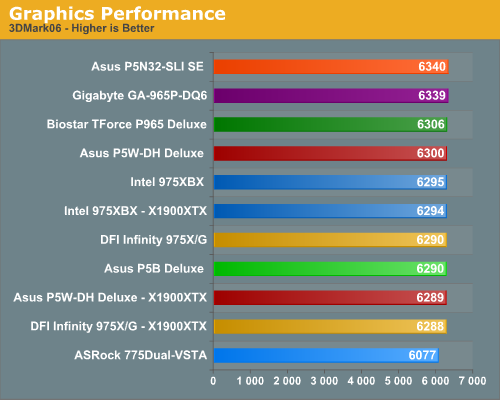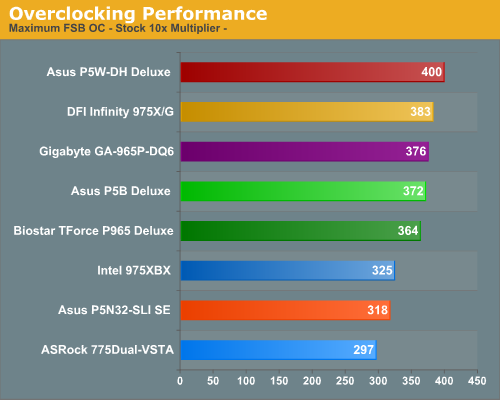Conroe Buying Guide: Feeding the Monster
by Gary Key & Wesley Fink on July 19, 2006 6:20 AM EST- Posted in
- Motherboards
General Performance
The PCMark05 benchmark, developed by Futuremark, was designed for determining overall system performance for the typical home computing user. This tool provides both system and component level benchmarking results utilizing subsets of real world applications or programs. This benchmark is useful for providing comparative results across a broad array of graphics cards, CPUs, hard disks, and memory configurations and it also includes some multithreading results. In this sense we consider the PCMark benchmark to be both synthetic and real world in nature while providing consistency in our benchmark results.

PCMark 2005 results for our test group are fairly close between the Intel chipset boards with the NVIDIA based ASUS P5N32-SLI SE taking a solid lead here due to excellent hard drive performance and multitasking scores within the benchmark. The three ATI X1900XTX equipped boards finished at the bottom of the group due to weak score results in the 2D benchmarks. Despite the close results in these tests with the Intel chipset boards, PCMark05 is still proving to be a useful overall performance benchmark. It is generally more sensitive than the older Winstones and PCMark04 to recent improvements in PC architecture.


We have replaced Winstones with 2 benchmarks that use rendering to test system performance. Cinebench 9.5 heavily stresses the CPU subsystem while performing graphics modeling and rendering. We utilize the standard benchmark demo within the program along with the default settings. Cinebench 9.5 features two different benchmarks with one test utilizing a single core and the second test showcasing the power of multiple cores in rendering the benchmark image.
While results are generally close in Cinebench, the ASUS P5N32-SLI SE tops the Dual-Core test results with the Intel 975XBX finishing a strong first in the single core tests, followed closely by the ASUS P5W-DH in both tests.
The 3DMark series of benchmarks by Futuremark are among the most widely used tools for benchmark reporting and comparisons. Although the benchmarks are very useful for providing apple to apple comparisons across a broad array of GPU and CPU configurations, they are not a substitute for actual application and gaming benchmarks. In this sense we consider the 3DMark benchmarks to be purely synthetic in nature but still valuable for providing consistent measurements of performance.

After taking a very strong first place in PCMark2005, we see the ASUS P5N32-SLI SE squeaking out a win in the 3DMark06 with an excellent performance turned in by the Gigabyte GA-965P-DQ6 for second place. The performance of the entire group was very close with the exception of the ASRock board due to its PCIe implementation (although a score over 6000 is still very respectable). The surprise was the ATI X1900XTX GPU scores as they have historically scored better in this benchmark than the NVIDIA based 7900GTX cards. We are still having conversations with ATI, but there appears to be a driver issue with the Core 2 Duo processors in our testing as the game scores will reflect the same results.
Overclocking Comparison

The overclocking capabilities we have measured thus far are with our standard E6700 CPU at a 10X multiplier. While this will not show the true FSB potential of the board, it does show a board's capability with the second highest performing Core 2 Duo and what can be expected with the fixed multiplier CPUs on average. We will be providing FSB overclocking results in our individual board reviews with the unlocked X6800. However, the only board in our testing that exceeded a 400FSB was the ASUS P5W-DH that reached 445MHz with our amazing little E6600 before running out of MCH voltage.
The NVIDIA based ASUS P5N32-SLI SE turned in a decent overclocking performance for an NVIDIA based Intel board but falls far short of the Intel chipset boards in high FSB overclocking. This situation will improve gradually over the next several months with the release of the DFI nF590 SLI board next month and then with the next true chipset revision this winter. Although the nForce4 Intel Edition board did not overclock competitively with the Intel chipsets when utilizing the FSB method, it did match the same overclocks when raising the CPU multiplier with our X6800 CPU.
The PCMark05 benchmark, developed by Futuremark, was designed for determining overall system performance for the typical home computing user. This tool provides both system and component level benchmarking results utilizing subsets of real world applications or programs. This benchmark is useful for providing comparative results across a broad array of graphics cards, CPUs, hard disks, and memory configurations and it also includes some multithreading results. In this sense we consider the PCMark benchmark to be both synthetic and real world in nature while providing consistency in our benchmark results.

PCMark 2005 results for our test group are fairly close between the Intel chipset boards with the NVIDIA based ASUS P5N32-SLI SE taking a solid lead here due to excellent hard drive performance and multitasking scores within the benchmark. The three ATI X1900XTX equipped boards finished at the bottom of the group due to weak score results in the 2D benchmarks. Despite the close results in these tests with the Intel chipset boards, PCMark05 is still proving to be a useful overall performance benchmark. It is generally more sensitive than the older Winstones and PCMark04 to recent improvements in PC architecture.


We have replaced Winstones with 2 benchmarks that use rendering to test system performance. Cinebench 9.5 heavily stresses the CPU subsystem while performing graphics modeling and rendering. We utilize the standard benchmark demo within the program along with the default settings. Cinebench 9.5 features two different benchmarks with one test utilizing a single core and the second test showcasing the power of multiple cores in rendering the benchmark image.
While results are generally close in Cinebench, the ASUS P5N32-SLI SE tops the Dual-Core test results with the Intel 975XBX finishing a strong first in the single core tests, followed closely by the ASUS P5W-DH in both tests.
The 3DMark series of benchmarks by Futuremark are among the most widely used tools for benchmark reporting and comparisons. Although the benchmarks are very useful for providing apple to apple comparisons across a broad array of GPU and CPU configurations, they are not a substitute for actual application and gaming benchmarks. In this sense we consider the 3DMark benchmarks to be purely synthetic in nature but still valuable for providing consistent measurements of performance.

After taking a very strong first place in PCMark2005, we see the ASUS P5N32-SLI SE squeaking out a win in the 3DMark06 with an excellent performance turned in by the Gigabyte GA-965P-DQ6 for second place. The performance of the entire group was very close with the exception of the ASRock board due to its PCIe implementation (although a score over 6000 is still very respectable). The surprise was the ATI X1900XTX GPU scores as they have historically scored better in this benchmark than the NVIDIA based 7900GTX cards. We are still having conversations with ATI, but there appears to be a driver issue with the Core 2 Duo processors in our testing as the game scores will reflect the same results.
Overclocking Comparison

The overclocking capabilities we have measured thus far are with our standard E6700 CPU at a 10X multiplier. While this will not show the true FSB potential of the board, it does show a board's capability with the second highest performing Core 2 Duo and what can be expected with the fixed multiplier CPUs on average. We will be providing FSB overclocking results in our individual board reviews with the unlocked X6800. However, the only board in our testing that exceeded a 400FSB was the ASUS P5W-DH that reached 445MHz with our amazing little E6600 before running out of MCH voltage.
The NVIDIA based ASUS P5N32-SLI SE turned in a decent overclocking performance for an NVIDIA based Intel board but falls far short of the Intel chipset boards in high FSB overclocking. This situation will improve gradually over the next several months with the release of the DFI nF590 SLI board next month and then with the next true chipset revision this winter. Although the nForce4 Intel Edition board did not overclock competitively with the Intel chipsets when utilizing the FSB method, it did match the same overclocks when raising the CPU multiplier with our X6800 CPU.










123 Comments
View All Comments
Gary Key - Thursday, July 20, 2006 - link
Thank you for the comments. Our focus on the first cooler roundup will be on units that cost under $25 but the Tuniq will be included as a reference point along with the retail Intel unit. Our follow up will include the high end air coolers and some water cooling units.The Tuniq is considered to be one of the best air coolers available at this time although we are starting to see this design being incorporated by other suppliers quickly.
biggersteve - Tuesday, September 19, 2006 - link
Hope you can get an Arctic Cooler Pro 7 into that cooler review. Quiet as a tomb and mighty cool.jonmcguffin - Thursday, July 20, 2006 - link
A feature built into the Core 2 Duo processors is this new Digital Thermal Sensor that supposedly has the ability to provide much quicker and more accurate thermal information about each processor. The key with this though is that it requires support from the motherboard. Why did you guys not mention this feature in any of the motherboards you tested?My guess is that since the P965 was "built" for Core 2 Duo, my guess would be that it supports this feature while the older 975 does not. In going back and forth between pro's and con's of the P965, if this feature is in fact built into the chipset/motherboard, it is worth pointing out. I'm not really an overclocker though I do want to buy a system that will be rock solid in stability for many years to come. Quite PC's that are very reliable and stable are critical and this is a good feature.
Also, you reviewed the Abit AB9 Pro motherboard a few weeks back but somehow it was left out of this overview. At $160 on the street, despite it's layout issue's, this looks to me like perhaps the best board right now for the guy who isn't rich and just wants a very solid Core 2 Duo mobo.
Hope you get a chance to review and respond.
Jon
Gary Key - Thursday, July 20, 2006 - link
Jon,The Gigabyte DQ6 actually has the ability to select readings from either sensor (Digital/Legacy) on the CPU in the power management settings. We will go over this in detail in our full review of the board or other Conroe capable boards in the future. These type of features along with audio and storage performance are not generally not reviewed in the guide articles but covered in the full product reviews.
The Abit AB9-Pro is shaping up to be a very good mid-range board (prices around $142 already) once the bios is complete. We are due to receive bios B6 next week that is optimized for Conroe and allows full memory configuration from both a timing and ratio viewpoint. The board was not ready to be included in the buyers guide until Abit had a final bios to us. We will report the results as soon as we complete testing.
Wesley Fink - Thursday, July 20, 2006 - link
We had planned to include the Abit AB9 in our roundup IF Abit got the memory issue fixed before the review. Unfortunately even the latest beta BIOS we received on Tuesday does not fix the issue. There is no means on the current Abit board to change memory speed or timings. It supposedly reads the SPD and boots at DDR2-533 5-5-5-15 with every dimm we tried. You can't run Value Ram at DDR2-800 for example or run DDR2-800 at rated speed. Or change timings to 3-2-3 at DDR-533 even if you know the ram can run at those timings. We did not think it fair to make a big deal of this in a review since Abit is supposedly working on it, but we see they are now also selling the board at some retailers and memory is still broken as far as we know.We consider this problem, if not fixed, to disqualify the Abit from consideration by any Enthusiast. We plan to do a full review of the Abit AB9 Pro if and when Abit fixes this major problem.
supremelaw - Thursday, July 20, 2006 - link
Jon,Why would more accurate thermal sensors
have high priority, if the Conroe runs
much cooler and more efficiently?
Are you planning extreme O/C, perhaps?
Wouldn't a superior HSF have higher priority?
e.g.:
http://www.supremelaw.org/systems/heatsinks/warnin...">http://www.supremelaw.org/systems/heatsinks/warnin...
Just curious here.
Sincerely yours,
/s/ Paul Andrew Mitchell
Webmaster, Supreme Law Library
http://www.supremelaw.org/">http://www.supremelaw.org/
falc0ne - Wednesday, July 19, 2006 - link
The usual best from Anandtech..I was in a bit of fog if switching to conroe or not, but now I have a mutch more clearer picture. After the part2 of this suite, it will all be clear to me.P.S. Your articles on Nvidia's NForce 4 platform made me choose that platform and AMD64.
My sincere thanks, I owe you a lot
wackypete - Wednesday, July 19, 2006 - link
Thanks for putting this article together. Your effort has not gone unnoticed.Howard - Wednesday, July 19, 2006 - link
Anybody know what chips it uses? The 5-5-5-15 DDR2-667 variety, that is.Gary Key - Wednesday, July 19, 2006 - link
We still have additional memory selections from a variety of suppliers arriving for further memory reviews at this time.